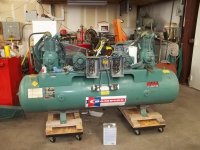LJ973GM
Plastic
- Joined
- Nov 2, 2009
- Location
- Chicagoland
So here is what I am working with
80 Gallon tank that was for a single compressor originally
I have QTY of 2 twin piston compressors and two matching motors
I am looking for the correct way to tee them into the tank without causing damage to either compressor.
I drilled out and tapped the tank for a larger 3/4" intank check valve since I had one laying around.
Now if I just take the outlets from both compressors and tee them up and send them to the in tank check valve will there be any potential harm to the compressors due to one working more efficiently than one another. One motor has a smaller pulley than the other.
The unloader at the in tank check valve will bleed off the air from the unit when PSI setting is reached but my concern is that due to different size pulleys one pump could harm the other pump or render it useless by pushing back at it.
I am trying to find out if I need to use inline check valves for each compressor.
Both compressor are actuated off the same pressure switch.
I know this is not the most ideal setup overall but I am looking for a high CFM delivery and I had the spare motor and compressor sitting around.
I am going to run this at 175 PSI not sure what CFM I will achieve but it should be better than one single pump.
Hope the info listed above with help provide a correct answer for the setup if not ask away and I will do my best to answer.
Thank you for any insight.
80 Gallon tank that was for a single compressor originally
I have QTY of 2 twin piston compressors and two matching motors
I am looking for the correct way to tee them into the tank without causing damage to either compressor.
I drilled out and tapped the tank for a larger 3/4" intank check valve since I had one laying around.
Now if I just take the outlets from both compressors and tee them up and send them to the in tank check valve will there be any potential harm to the compressors due to one working more efficiently than one another. One motor has a smaller pulley than the other.
The unloader at the in tank check valve will bleed off the air from the unit when PSI setting is reached but my concern is that due to different size pulleys one pump could harm the other pump or render it useless by pushing back at it.
I am trying to find out if I need to use inline check valves for each compressor.
Both compressor are actuated off the same pressure switch.
I know this is not the most ideal setup overall but I am looking for a high CFM delivery and I had the spare motor and compressor sitting around.
I am going to run this at 175 PSI not sure what CFM I will achieve but it should be better than one single pump.
Hope the info listed above with help provide a correct answer for the setup if not ask away and I will do my best to answer.
Thank you for any insight.


